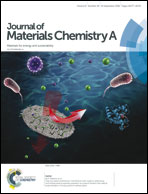How to teach an old dog new (electrochemical) tricks: aziridine-functionalized CNTs as efficient electrocatalysts for the selective CO2 reduction to CO†
Abstract
The electrocatalytic conversion of CO2 to energy-rich chemicals or energy vectors is a highly challenging approach to cope with an ever increasing demand for energy storage and valorization of renewable resources. Herein we report on the electrocatalytic reduction of CO2 to CO using covalently N-decorated carbon nanotubes as highly efficient and chemoselective metal-free electrocatalysts. At odds with more conventional synthetic methods for the production of N-doped nanocarbons, chemical functionalization warrants a unique control of “surface N-defects” available for the process, ruling out any synergistic contribution to electrocatalysis coming from other surface or bulk N-containing groups. With a CO faradaic efficiency (FECO) close to 90% and productivity as high as 48 NLCO gN−1 h−1, NH-aziridine functionalized MWCNTs have shown CO2RR performance that is among the highest reported so far for related metal-free systems. At the same time, it has offered a unique view-point for the comprehension of the underlying structure–reactivity relationship.



 Please wait while we load your content...
Please wait while we load your content...